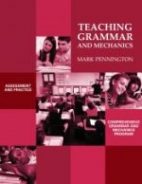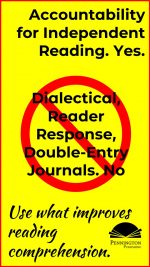Assessment-Based Differentiated Instruction
Rick,
… My point is that teachers need to be the ones making informed choices about how to differentiate instruction, not students. Student choice re: content and process is at best “the blind leading the blind.” I do agree with your practical emphasis on what works, as long as the teacher sets the agenda.
Mark Pennington (February 16th, 2010)
Mark,
I think there’s still room for a student’s sense of what he needs to learn to help teachers orchestrate the learning experience. For example, a student might claim that flash cards don’t really help him learn vocabulary so much as a another strategy does, and he’d like to use this other strategy. He asks the teacher about using this other strategy, and effective teachers usually say, “Let me get out of your way and let you learn.” If we’re not teaching the process itself, it doesn’t matter how students learn it, as long as they learn it well. We don’t want to limit students to our imagination. Students have important insights into their own learning that our curriculum and student overload doesn’t always allow us to see. This does not change the teacher’s agenda, and it would be a mistake to summarily dismiss such input from our thinking as we teach.
Rick Wormeli (February 17th, 2010)
Rick,
As a staff developer and district reading specialist for five years during the 1990s in Elk Grove Unified (the third largest school district in California), I had the opportunity to visit countless elementary classrooms. Student-choice learning including “Learning Centers,” “Free-Choice Fridays,” unsupervised “SSR” (student selected books with no accountability), “Learning Style” assignments in which kinesthetic learners acted out, rather than wrote essays, “Multiple Intelligences Learning” in which students could choose to create a written report, oral report, a song/rap, or create a model (countless sugar cube castles, DNA double helices, dioramas)… I could go on… were prominent features of many classrooms. Not only was a substantial portion of the daily content in the hands of students, teachers also devolved the methods of learning to their students via the “in” educational instructional fad which promoted student-choice learning. Reading test scores hovered in the 40th percentiles for years, especially in the middle and lower SES schools.
Enter a swing in the pedagogical pendulum, away from constructivist student-centered learning to teacher-directed, standards-based learning and away from whole language reading instruction to phonics-based reading instruction. Elk Grove Unified adopted Open Court® Reading—which utilized a scripted instructional block and “workshop” in which reading instruction was differentiated according to formative data. Most teachers, at first, hated the tightly-bound curriculum, and especially the differentiated “workshop.” Learning how to organize and implement differentiated instruction was very challenging. Both teachers and reading specialists experimented and shared successes and failures of their “workshops.” As teacher expertise improved, reading scores jumped within two years to the 60th percentiles and have remained there for a dozen years. Certainly, the change in the what of instruction mattered, but the how of instruction may have mattered more. Most of us credited the teacher-directed differentiated instruction of “workshop” as the key factor in improving student scores across all demographics.
Beyond that eye-opening elementary experience, I’ve taught sixteen years at the middle school level, eight at the high school level, and three at the community college level. From my own teaching experience, and (more specifically) the learning experiences of my students, I’ve gleaned a few more morsels about whether teachers or students should be in charge of the what and how of learning.
A nine-year-old, twelve-year-old, sixteen-year-old, and twenty-year-old all seem to share a few common developmental learning characteristics: First, most would take the path of least resistance to reach their goals. Few are mature enough to include learning skills and concepts as key components of these personal goals. Students want the grades and the related self-satisfaction; they want access to the next class and/or school; they want to keep their parents off of their backs–in other words, they are human. We were once as they are.
Our understanding of the characteristics and proclivities of our students should inform both the what and the how of instruction. Consider this: students don’t know what they don’t know. To devolve the what of instruction to student choice is to abrogate our responsibilities as the informed, objective decision-makers. Teaching professionals know what our students do and don’t know. Furthermore, to delegate the how of learning to students seems akin to educational malpractice. Do we really want to entrust the how of instruction to an eight-year old student and agree that Johnny knows best how to learn his multiplication tables? Do we really want to allow middle schoolers to choose whether they can listen to their iPods® while they silently read Chapter 24 of their social studies textbooks? Students don’t know how to best learn what they don’t know. How could they? If they did know the how, they would already know the what, especially if what was perceived as relevant to their immediate wants and needs. They don’t. We teachers do best know how they learn. We have the training, results, and informed judgment.
Now, I’m not a stuffy autocrat who says “My way or the highway” and, of course, there is always another imaginative “way to teach this.” Sure, some choice can increase student motivation and “one-size fits all” ways to problem-solve or learn a concept or skill may not get the job done for some students; however, even these choices are most efficiently and effectively teacher-driven and modeled. For example, in composition, some students prefer to draft first and revise thereafter; others prefer to integrate the drafting and revision process. Wouldn’t a teacher-led “think-aloud” modeling these two composition processes make sense? Students learn which option or combination thereof works best for them through teacher direction, not from a sink or swim, work it out yourself, trial and error process. Far from “getting out of the way and letting them learn,” teachers need to actively direct both the what and how of the learning process.
Frankly, I am much more concerned about the what, than the how, in terms of differentiated instruction. If teachers buy-in to assessment-based instruction, based upon diagnostic and formative assessments, the battle is chiefly won and DI (differentiated instruction) is an easy sell. However, most teachers aren’t there yet. There are reasons that teachers resist differentiated instruction, and until teacher buy-in, the how of instruction is a relatively fruitless pursuit. When more teachers get there, we can continue the “skirmishing” re: student choice and the how of effective instruction and learning.
Mark
*****
I’m Mark Pennington, author of the full-year interactive grammar notebooks and the traditional grade-level 4, 5, 6, 7, 8 and high school Teaching Grammar and Mechanics programs. Teaching Grammar and Mechanics includes 56 (64 for high school) interactive language conventions lessons, designed for twice-per-week direct instruction in the grade-level grammar, usage, and mechanics standards. The scripted lessons (perfect for the grammatically-challenged teacher) are formatted for classroom display. Standards review, definitions and examples, practice and error analysis, simple sentence diagrams, mentor texts with writing applications, and formative assessments are woven into every 25-minute lesson. The program also includes the Diagnostic Grammar, Usage, and Mechanics Assessments with corresponding worksheets to help students catch up, while they keep up with grade-level, standards-aligned instruction.
Grammar/Mechanics, Reading, Spelling/Vocabulary, Study Skills, Writing



